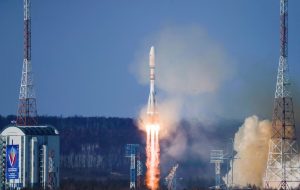Iran’s private sector joins space race
TEHRAN – Decades of crippling sanctions would likely deter most nations from pursuing complex, challenging, and often exclusive projects like a sophisticated space program. But for Iranians, no amount of pressure from foreign entities can stop the nation from reaching for the stars. In a landmark achievement for Iran’s space industry on Tuesday, the country


TEHRAN – Decades of crippling sanctions would likely deter most nations from pursuing complex, challenging, and often exclusive projects like a sophisticated space program. But for Iranians, no amount of pressure from foreign entities can stop the nation from reaching for the stars.
In a landmark achievement for Iran’s space industry on Tuesday, the country successfully launched its first privately-developed satellites, Kowsar and Hodhod, into orbit aboard a Russian Soyuz launcher. This marked the inaugural foray of the private sector into Iran’s space exploration endeavors.
Kowsar, a 30-kilogram high-resolution sensing satellite, is designed for a range of applications including agriculture, natural resource management, environmental monitoring, and disaster response. Its impressive 3.45-meter resolution surpasses Iran’s own target for satellite camera technology by 2025. With a lifespan of 3.5 years, Kowsar will orbit at an altitude of 500 kilometers, capturing six frames per second across a 15-kilometer range.
Hodhod, meanwhile, is a smaller communications satellite designed to enhance satellite-based communication networks and expand IoT connectivity. This CubeSat will operate in a 500-kilometer orbit, providing communications solutions for remote and underserved regions. Hodhod’s mission will support precision agriculture, transportation, logistics, and environmental monitoring.
The CEO of the knowledge-based company behind the design and development of the satellites says it took his team 15 years of dedicated work to finally witness Hodhod and Kowsar successfully launched into orbit. “This is only the beginning for us, we are only going forward from here,” Faghih Imani said after personally assessing the launch of the two satellites in Russia.
This success story is a continuation of Iran’s impressive space journey. Earlier this year, the country successfully launched the indigenous Mahda research satellite using the domestically produced Simorgh (Phoenix) satellite launch vehicle. This bold move proved Iran’s capability to develop its own launch vehicles, a crucial step towards self-reliance in space exploration.
The IRGC Aerospace Force also showcased its prowess last year by flawlessly launching the Soraya satellite into orbit in a record-breaking 11 minutes, using the domestically developed Qaem-100 SLV. This three-stage, solid-fuel rocket, a testament to Iranian engineering ingenuity, solidified the country’s commitment to a self-sufficient space program.
Iran now stands proudly amongst the top 10 nations with the capability to design, build, and launch its own satellites.
In an interview on Tuesday, the head of the Iranian Space Agency (ISA) underscored the critical role of the private sector in advancing the country’s space industry. “Achieving significant goals in this field is unattainable without robust participation from private enterprises. We believe that the private sector should enter this field in a competitive environment, considering market criteria.”
The official noted that numerous universities and research institutes have been pivotal in fostering activities within the space sector, setting the stage for private sector involvement. “Many individuals working in knowledge-based companies originated from these academic and research environments.”
The ISA chief further announced that Iran plans to launch an additional 5 to 7 satellites by the end of the Iranian calendar year (March 20), with both the government and private sector participating in this ambitious effort.
“With each launch, we inch closer to joining the ranks of space giants like Russia, China, and the United States.”
With every launch, Iran sends a clear message to the world: its ambition in space is unyielding, and its resolve to overcome obstacles unbreakable. This determination, coupled with a commitment to developing its own technologies, ensures that Iran’s journey into the cosmos is a story still unfolding, full of potential and promise.
